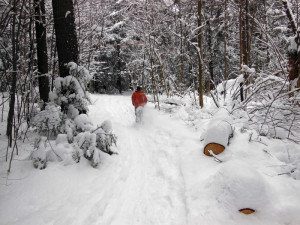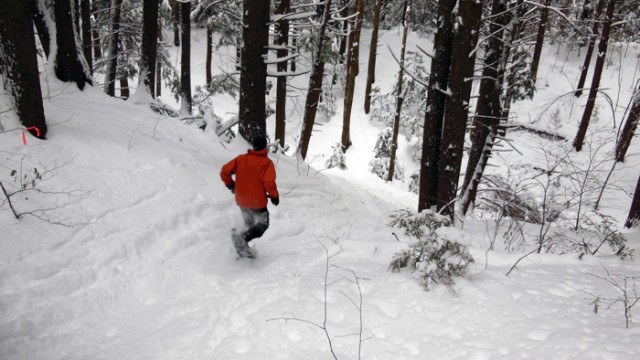Have you tried running in winter? How about on snow? With snowshoes? OK, I’ll admit it, I hadn’t either . . . until very recently.
I might feel like I’m 35 (alright, 38) with collapsed arches, but the fact remains that at the age of 53, I am suddenly (and, unexpectedly) getting older every day. For the last 20 years I’ve been trying to forestall the aging phenomenon by doing a little running, a little cycling, some hiking, and skiing. My plan is to make it (on my own two aching feet if possible) to age 100 before sleeping for the rest of my life. So, when Executive Editor Tim Jones suggested I try running in snow as another good way to get outdoors more in winter, I was, like … you know, Cool!
Man, I am here to tell you that it is hard…and exhilarating! And if you thought cross-country skiing was a full body workout that demanded a lot of stamina and strength in your large muscle groups, baby, running in deep snow will whip you into shape pretty quickly (if it doesn’t kill you first). But then Tim mentioned snowshoes built for running and I said, “Oh? So I should put snowshoes on?!?” Okay, so maybe I’m a little slow on the uptake.
So I let a couple of days pass to recover from my postholing exercise (Thankfully, no one was taking pictures!) Over the New Year’s weekend in Jericho, VT, I tried a pair of Kahtoola RNR snowshoes in a foot of fluff on top of a good eight inches of denser snow. The RNR snowshoes are just 22 inches long and eight inches wide, and 2 lbs., 13 oz. per pair with bindings. According to the instructions, the adjustable “WingSpan” binding lets you match the width of the binding to fit almost any footwear from a woman’s size 6 running shoe to a man’s size 14 insulated boot.
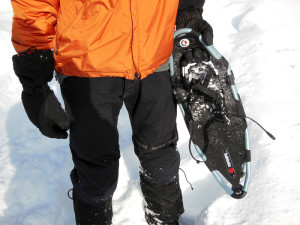
No tools required; just do it inside after you decide what shoe is going to be your winter running kicker. I adjusted the RNRs to my trail runners the night before venturing out. Each binding has a rubberized flap that can be peeled back to expose two clevis pins secured by cotter pins. Pushing the clevis out lets you then swing in or out two composite wings to hug your shoe’s width. Finding the right setting for my size 10 Merrell Chameleons was easy.
Dress appropriately and start slow
Here’s the thing about running in snowshoes: You’re going to get warm fast and tired even faster than you can imagine. That makes it a very time-efficient way to exercise. If you regularly run four miles in the other seasons, don’t expect to go four miles in snow right off the bat. Or, if you’re in super shape to start with, you might be able to run those four miles, but expect to give it a lot more effort. And while it’s great that it warms you up fast, the issue with exertion in cold weather is that you want to make sure to stay dry.
Do I need to say it? No cotton, no cotton, no cotton.
You’re going to sweat running in snow, so it’s essential that wicking fabrics against your skin can pull that sweat away to the exterior where it can evaporate! Wear three layers for alpine? Try two for serious aerobic activity. If you step outside dressed to run and you are comfortably warm, you are WAY overdressed.
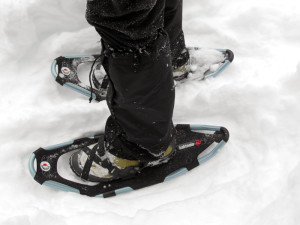
Here’s my admission: If it’s not at least 12 degrees Fahrenheit on the thermometer outside my bedroom window, I’m staying inside on the NordicTrack. But, if the mercury creeps north of that arbitrary number, I’m pulling on wicking winter compression shorts, a thin long base layer and a pair of poly Sporthill XC pants (which I’ve had so long they are getting thin at the knees). A good pair of gaiters will help keep your ankles and feet happy. On top I’m always experimenting, but a good base layer plus a wicking thermal top with a zip turtleneck is a must. On top of that is anyone’s guess. (More on that in a few paragraphs.)
Sometimes a wind-blocking vest is enough. Other days a breathable nylon windbreaker with plenty of venting will do it. I top it off with a thin beanie that’ll cover my ears and a pair of good athletic sunglasses. I wear mittens that are easy to pull off and carry in my hands if my fingers start to feel clammy. If I’m cold when I walk outside, I know I’m not overdressed. Some winter runners carry a fanny pack with compact wind pants and an extra top layer.
Don’t forget the water and tell ‘em where you’re going
It’s easy to get lulled into thinking you’re not thirsty in cold weather. Don’t let this happen to you. For beginners, hydrate well before heading out and just do a couple miles at the most. If you start running in snow on a regular basis and start finding you can get to the four-mile mark and beyond, bring water.
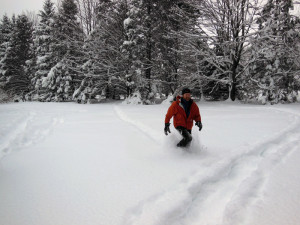
A bunch of us headed into the Jericho Town Forest and I stepped into the Kahtoola RNRs. The toes are secured by nylon strap that’s easy to cinch down. The buckle system consists of an aluminum buckle with a fixed tab. Pull the stretchy rubber heel strap back to the appropriate hole in the strap, tuck the remainder into a nylon clip, and you’re ready to go. Easy, even with mittens or gloves on!
It might be a good idea to pick an open field if you’re a first timer. My choice was a flat trail alongside a track cut by Nordic skiers. Be sure to leave a note or tell your family where you’re headed and for how long. In winter, if something happens, you want to be found sooner rather than later.
I started running and the compactness of the snowshoes made it feel like second nature. I quickly found an easy, natural gait and immediately wondered where all the snow was coming from. These snowshoes have tight toe cords (one of the things you have to consider when picking snowshoes) and the running action, depending on the density and depth of the snow, will kick more or less snow up and onto your back with each stride. That’s why I think a waterproof shell helps.
Just for fun I took the snowshoes off at one point and tried running without them. I started slipping side to side and struggling to stay on my feet. The snowshoes clearly did a phenomenal job of stabilizing each step with enough flotation to maintain forward progress.
Running in snowshoes is a work-out, make no mistake, but it opens up a whole new way of staying active. It offers a whole other reason for looking forward to fresh snow and you can achieve a tremendous aerobic and anaerobic workout in a very short time.
Since the beginning of the year, I’ve found myself running on snowshoes whenever the snow allowed for it, once on a fresh four inches and a few other times on older snow with a paper-thin crust. Both times, the shoes kept me firm in my stride and happy to be out. See you out there!
